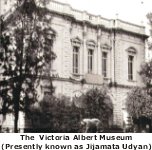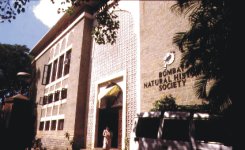About
BNHS
The Bombay
Natural History Society is today the largest non-government organisation (NGO) in the Indian
subcontinent engaged in nature conservation research . In
the 117 years of its existence, its commitment has been, and continues to
be, the conservation of India's natural wealth, protection of the environment
and sustainable use of natural resources for a balanced and healthy development
for future generations. The Society's guiding principle has always been that
conservation must be based on scientific research - a tradition exemplified by
its late president, Dr. Sálim Ali.
(NGO) in the Indian
subcontinent engaged in nature conservation research . In
the 117 years of its existence, its commitment has been, and continues to
be, the conservation of India's natural wealth, protection of the environment
and sustainable use of natural resources for a balanced and healthy development
for future generations. The Society's guiding principle has always been that
conservation must be based on scientific research - a tradition exemplified by
its late president, Dr. Sálim Ali.
Altruism, is the key word for
the success and growth of the Society. This vital element, as fund support or
non-financial support, be it from its members, government, institutions or
corporate bodies, has been responsible for the survival of the Society. To
ensure the continuity of its contribution to the cause of conservation, the BNHS
invites support from all those who care to make a better world for all living
beings, including mankind.
Origin
 In 1883, eight residents
of Bombay (now Mumbai) decided to form a Society for the study of Natural
History. Six Englishmen and two Indians met on the 15th of September 1883 in the
Victoria and Albert Museum (presently named as Jijamata Udyan), Bombay and
constituted themselves as the Bombay Natural History Society. They
proposed to meet monthly and exchange notes, exhibit interesting specimens and
otherwise encourage one another. For several months meetings were held in the
Victoria and Albert Museum. Then in January 1884, Mr. H. Phipson offered the use
of a room in his office at 18 Forbes Street, Fort, Bombay, for holding
meetings.
In 1883, eight residents
of Bombay (now Mumbai) decided to form a Society for the study of Natural
History. Six Englishmen and two Indians met on the 15th of September 1883 in the
Victoria and Albert Museum (presently named as Jijamata Udyan), Bombay and
constituted themselves as the Bombay Natural History Society. They
proposed to meet monthly and exchange notes, exhibit interesting specimens and
otherwise encourage one another. For several months meetings were held in the
Victoria and Albert Museum. Then in January 1884, Mr. H. Phipson offered the use
of a room in his office at 18 Forbes Street, Fort, Bombay, for holding
meetings.
Soon the
membership increased and collections began to be made. In a very short time, the
necessity for more ample accommodation was felt.  Mr. Phipson again came to
the rescue of the Society and both his office and the Society moved to a
larger and more suitable accommodation at 6, Apollo Street, (presently Shaheed
Bhagat Singh Road). This association was to last for the next 74 years to the
everlasting benefit of the Bombay Natural History Society. However, as the
collections began to grow at 6, Apollo Street, the need to have a proper museum
was felt. Mr. Phipson's desire to have a proper Natural History Museum in Bombay
was soon fulfilled, when on 15th August 1905, it was resolved by the Government
to have a permanent memorial to commemorate the visit of the Royal Highnesses,
the Prince and Princess of Wales to this City and Presidency in the form of a
public Museum and Library.
Mr. Phipson again came to
the rescue of the Society and both his office and the Society moved to a
larger and more suitable accommodation at 6, Apollo Street, (presently Shaheed
Bhagat Singh Road). This association was to last for the next 74 years to the
everlasting benefit of the Bombay Natural History Society. However, as the
collections began to grow at 6, Apollo Street, the need to have a proper museum
was felt. Mr. Phipson's desire to have a proper Natural History Museum in Bombay
was soon fulfilled, when on 15th August 1905, it was resolved by the Government
to have a permanent memorial to commemorate the visit of the Royal Highnesses,
the Prince and Princess of Wales to this City and Presidency in the form of a
public Museum and Library.
It was only in
1921, when the museum was built that the bulk of the collections were
transferred to the Prince of Wales Museum. The foundation stone of the new
wing of the Museum presently housing the Natural History section was formally
laid in 1933 as part of the Golden Jubilee programme. The Museum exhibits are a
tribute to the talent of the Society's two officers of that period, S. H.
Prater, the Curator and C. McCann, the Asst. Curator. The Natural History
Section of the Prince of Wales Museum was under the management of the
Society.
Ten years
after Independence, an agreement with the Museum and the State Government was
concluded by which the Society severed its connections with the Museum, and the
Government of Maharashtra agreed to pay for housing the Society's collections
other than the exhibits at the Museum and the establishment to maintain them .
At this time, the association with Phipsons also came to an end.
Realising the
importance of the Bombay Natural History Society's vital role in documenting and
conserving India's natural heritage, the Government of India agreed to fund the
building of "Hornbill House" to house the Bombay Natural History Society and its
valuable collections of natural history specimens representing India's faunal
biodiversity.
Hornbill House
 Hornbill
House was built by the Prince of Wales Museum with a grant of Rs. 3.34 lakhs
from the Ministry of Scientific Research and Cultural Affairs, Government of
India for the exclusive use of the BNHS. Construction of Hornbill House was
completed in 1965. Hornbill House is named after the Society's mascot the Great
Indian Hornbill, which is the logo of the Society.
Hornbill
House was built by the Prince of Wales Museum with a grant of Rs. 3.34 lakhs
from the Ministry of Scientific Research and Cultural Affairs, Government of
India for the exclusive use of the BNHS. Construction of Hornbill House was
completed in 1965. Hornbill House is named after the Society's mascot the Great
Indian Hornbill, which is the logo of the Society.
Hornbill House
is located at Padma Vibhushan Dr. Sálim Ali Chowk - named after India's most
famous ornithologist whose close association with the Bombay Natural History
Society extended over 78 years from the time he entered its portals as a curious
youngster until his demise in 1987 at the age of 91. Dr. Sálim Ali was the
Society's first Indian Honorary Secretary and was its President at the time of
his death. During his later life, the Bombay Natural History Society became
synonymous with him.
The Society's Crest or Logo
In the first
fifty years of its existence, the Society apparently did not have a distinct
logo of its own, though the mounted antlers of a barasingha do appear on the
cover of the Golden Jubilee Commemorative volume of the Journal.
 In 1933, however, the then
Honorary Secretary advised that the Journal would attract more attention
in libraries and clubs if there was a coloured illustration on the cover. He had
then obtained a suitable design for a crest which featured the Great Indian
Hornbill which had been always associated with the Society and recommended that
this crest be printed in colour on the Society's Journal and on the
prospectus of the Society. He also proposed that a replica of this crest be used
for the Society's stationery.
In 1933, however, the then
Honorary Secretary advised that the Journal would attract more attention
in libraries and clubs if there was a coloured illustration on the cover. He had
then obtained a suitable design for a crest which featured the Great Indian
Hornbill which had been always associated with the Society and recommended that
this crest be printed in colour on the Society's Journal and on the
prospectus of the Society. He also proposed that a replica of this crest be used
for the Society's stationery.
The Society's
association with the Hornbill dates back to
"William", the Great Pied Hornbill which arrived at the Society as a nestling in
1894, and had lived in the Society's rooms till 1920. William, affectionately
known as the office canary, lived in a cage behind the Honorary Secretary's
chair during the 26 years he lived at the Society. Hornbill House was named
after him.
We are situated
at
Bombay Natural History
Society,
Hornbill House,
Shaheed Bhagat Singh Road,
Mumbai 400 023,
INDIA.
Phone: (91-22) 22821811 Fax: (91-22)22837615
 (NGO) in the Indian
subcontinent engaged in nature conservation research . In
the 117 years of its existence, its commitment has been, and continues to
be, the conservation of India's natural wealth, protection of the environment
and sustainable use of natural resources for a balanced and healthy development
for future generations. The Society's guiding principle has always been that
conservation must be based on scientific research - a tradition exemplified by
its late president, Dr. Sálim Ali.
(NGO) in the Indian
subcontinent engaged in nature conservation research . In
the 117 years of its existence, its commitment has been, and continues to
be, the conservation of India's natural wealth, protection of the environment
and sustainable use of natural resources for a balanced and healthy development
for future generations. The Society's guiding principle has always been that
conservation must be based on scientific research - a tradition exemplified by
its late president, Dr. Sálim Ali.



